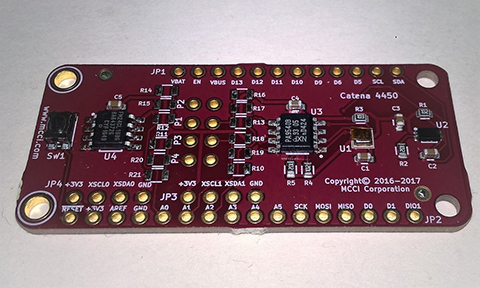Catena 4450
Integrated LoRaWAN™ Technology Node
The MCCI Catena® 4450 Node for LoRaWAN™ technology is a powerful open-source IoT device designed specifically for use with The Things Network. Based on the Adafruit Feather M0 system, the Catena 4450 is a ready-to-use platform for LoRaWAN 1.0 and 1.1 wireless IoT applications.
Although it's available in several variants, the recommended base configuration consists of:
- The Adafruit Feather M0 board. Features:
- ARM Cortex M0 CPU at 48 MHz
- 256 kilobytes of flash program memory
- 32 kilobytes of static RAM
- 900 MHz LoRa® radio from Hope RF
- USB port for charging and programming
- Compatible with a wide range of Adafruit Feather Wings
- Battery charging circuit for LiPo batteries
- Fifteen I/O pins with a variety of supported protocols
- The Catena 4450 sensor daughterboard, including:
- Configuration jumpers for optimum performance with LoRaWAN;
- 2 kbytes of ferro-electric RAM (FRAM) for non-volatile storage of network parameters, session keys, and application data (fully meeting requirements of LoRaWAN 1.1);
- A Bosch BME-280 sensor, measuring temperature, humidity, and barometric pressure;
- A lux sensor, measuring from 0 to 65,536 lux of ambient light;
- An I2C expansion multiplexer, for adding additional I2C devices externally;
- Screw terminals (on the M101 and M102 assembled models) for connecting external sensors.
- A whip antenna.
- A 350 mAh Lithium Polymer ("LiPo") battery.
All units (other than the WING-ONLY variant) are shipped assembled and tested, with built-in software that is ready for use with The Things Network on the US915 band plan.
With suitable software, the radio supports the common LoRaWAN band plans used in the United States and Europe. The standard whip antenna is tuned for the US-915 band plan of The Things Network.
A number of variants are available as standard products.
The BASE, M101 and M102 variants are all complete units. They vary only in the population of the resistor option field. The M101 is configured for use in electric power monitoring applications. The M102 is configured for use with soil and water probes for smart agriculture applications. The BASE unit leaves the resistor field unpopulated to allow users to make their own adaptations.
The DIY-KIT variant is sold unassembled, but gives the most flexibility for use and deployment.
The DIY-FACTORY variant is the DIY-KIT assembled and tested.
The WING-ONLY variant is the Catena 4450 wing without the CPU board, and without headers. It is great for experimenters who want to breadboard more complex solutions.
For more info, check this blog post on the Adafruit site.
Software is available.
Contact us for more details.
Volume discounts and custom variants are available.
About
For over twenty years we've been developing and licensing USB system software to be embedded into our customers’ consumer-electronics products.
Contact
Use our contact page to connect with us. We will work with you to meet your needs.
Updates
Stay up to date with our work and get updates delivered right to your inbox.



